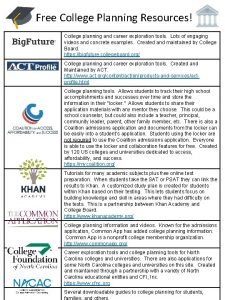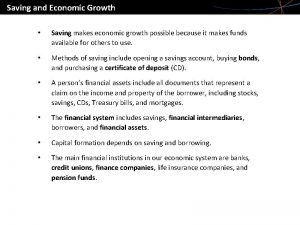College Planning Saving for a College Education Saving





























- Slides: 29

College Planning Saving for a College Education

Saving for College Fitting College Savings into Your Budget Your money

Saving for College The Cost of College Now $49, 870 $21, 950 Cost figures include direct billed costs of tuition, fees, room, and board. Source: College Board, Trends in College Pricing 2019 4 -year public 4 -year private 2019 -2020

Saving for College The Future Cost of College 4 -year public: 2019 -2020 = $21, 950 2024 -2025 = $28, 014 2029 -2030 = $35, 754 2019 -2020 2024 -2025 2029 -2030 4 -year private: 2019 -2020 = $49, 870 2024 -2025 = $63, 648 2029 -2030 = $81, 233 Projected costs based on annual 5% college inflation rate

Saving for College How Are You Going to Pay? Gifts from grandparents Other borrowing options Your college savings Creative cost-cutting measures Financial aid Income in the college years

Setting a Savings Goal Monthly Investment 5 years 10 years 15 years $100 $6, 977 $16, 388 $29, 082 $300 $20, 931 $49, 164 $87, 246 $500 $34, 885 $81, 940 $145, 409 Figures are based on a 6% average annual after-tax return. This hypothetical example is used for illustrative purposes only and does not represent the performance of any specific investment. Fees and expenses are not considered and would reduce the performance shown if they were included. Actual results will vary. This illustration assumes a fixed annual rate of return, but rates of return will vary over time, particularly for long-term investments.

College Savings Options 529 plans* Coverdell Education Savings Accounts* Mutual funds, stocks, ETFs Savings accounts Money market funds CDs Roth IRAs* * Tax-advantaged accounts

College Savings Options Taxable vs. Tax-Free Figures are based on a $25, 000 initial investment and assume a 6% average annual return and a total combined federal and state tax rate of 28%. This is a hypothetical example and is not intended to reflect the actual performance of any specific investment, nor is it a guarantee of future value. The lower maximum tax rates on capital gains and qualified dividends, as well as the tax treatment of investment losses, would make the taxable investment more favorable than is shown on this chart.

College Savings Options 529 Plans Q. What is a 529 plan? A. A 529 plan is a tax-advantaged college savings vehicle 529 plans are sponsored by states, but must adhere to federal law Investors should consider the investment objectives, risks, charges, and expenses associated with 529 plans before investing. More information about 529 plans is available in each issuer's official statement, which should be read carefully before investing. Also, before investing, consider whether your state offers a 529 plan that provides residents with favorable state tax benefits. Other state benefits may include financial aid, scholarship funds, and protection from creditors.

College Savings Options 529 Plans College savings plan Prepaid tuition plan Individual investment-type account; your contributions go into plan’s preestablished investment portfolios that you select; returns aren’t guaranteed Contract between you and the plan whereby your contribution today covers a certain amount of in-state public college tuition in the future Offered by nearly all states; you can join any state’s plan Only a few states offer them; you are limited to your own state’s plan Funds can be used for tuition, fees, room and board, books, and supplies at any accredited college in U. S. or abroad Generally covers in-state tuition at public colleges only (exception: one private college prepaid plan in is existence)

College Savings Options 529 Plans Advantages Anyone can open an account High lifetime contribution limits You control the account funds Age-based portfolios Tax benefits § Tax-deferred accumulation § Tax-free earnings

College Savings Options 529 Plans Accelerated gifting – Estate planning advantage $75, 000 (individual) or $150, 000 (couple) lump-sum gift No gift tax owed if certain conditions are met

College Savings Options 529 Plans Limitations Returns aren’t guaranteed Limited to plan’s investment portfolios Can change investment options on existing contributions only twice per year Withdrawals not used for qualified education expenses are subject to income tax and penalty Fees and expenses

College Savings Options Coverdell ESAs $2, 000 maximum annual contribution For elementary, secondary, or college expenses You select investments Tax-free earnings Earnings portion of withdrawal used for non-educational purpose subject to income tax and 10% penalty Eligibility based on income

College Savings Options Roth IRAs Retirement savings vehicle Parents younger than 59½ won’t owe 10% early distribution penalty if money is used for college Retirement accounts not counted as asset in financial aid formulas Maximum annual contribution $6, 000 ($7, 000 if 50 or older) Ability to contribute depends on income Retirement funds will be reduced Generally, nonqualified withdrawals of earnings from Roth IRAs will be subject to regular income taxes (and a 10% early distribution penalty unless an exception applies). Qualified withdrawals may occur after the account has been held for at least five years, and the account holder reaches age 59½, dies, or becomes disabled.

College Savings Options Mutual Funds & Stocks Offer variety and flexibility No tax advantages specific to education $25, 000 investment averaging 6% return per year for 18 years = $53, 525 in taxable mutual fund (combined federal & state tax rate of 28%) and $71, 358 in a tax-free 529 plan ─ difference of $17, 833 Mutual fund investing involves risk and possible loss of principal. Investors should consider the investment objectives, risks, charges, and expenses of mutual funds carefully before investing. The prospectus contains this and other information, and should be read carefully before investing.

College Savings Options Which Options Are Right for You? 529 plans Coverdell ESAs Roth IRAs Mutual funds & stocks Open to anyone High or no contribution limit Full investment control Tax-free earnings Flexibility – no penalty if funds not used for college Not counted for financial aid purposes

College Savings Options Hypothetical Family Heather and Joe, 43 years old Two children, 7 and 4 Combined income of $155, 000 $26, 000 windfall Would like to make monthly contributions to a college fund

College Savings Options Hypothetical Family Coverdell ESA: meet income limits, buy stocks Roth IRA: meet income limits 529 plan: automatic monthly contributions ? Mutual funds & stocks

Saving for College How Are You Going to Pay? Gifts from grandparents Other borrowing options Your college savings Creative cost-cutting measures Financial aid Income in the college years

Financial Aid What Is Financial Aid? Loans Grants Scholarships Work-study

Financial Aid Using a Net Price Calculator Federal grants ─ based on financial need only College grants ─ based on financial need and merit Net price calculators

Financial Aid How Is Financial Need Determined? Income, assets, family information Federal or institutional methodology Expected family contribution (EFC) Cost of college minus EFC equals financial need

Financial Aid Assets Excluded from Consideration Home equity All retirement accounts Annuities Cash value life insurance

Financial Aid Loans Federal student loans - Direct Loans Parent loans – PLUS Loans Private student loans Beware excessive loans!

Financial Aid How Much Should You Rely on Aid? Don’t rely too heavily on financial aid All aid isn’t created equal Focus on your savings

Saving for College and Retirement It’s a balancing act, but you should save for retirement now, too, because. . . There are no loans, grants, or scholarships for retirement Miss out on years of tax-deferred growth; hard to catch up later Allocate some funds for retirement and some for college Err on the side of saving for retirement

Thank You

Disclaimer IMPORTANT DISCLOSURES Broadridge Investor Communication Solutions, Inc. does not provide investment, tax, or legal advice. The information presented here is not specific to any individual's personal circumstances. To the extent that this material concerns tax matters, it is not intended or written to be used, and cannot be used, by a taxpayer for the purpose of avoiding penalties that may be imposed by law. Each taxpayer should seek independent advice from a tax professional based on his or her individual circumstances. These materials are provided for general information and educational purposes based upon publicly available information from sources believed to be reliable—we cannot assure the accuracy or completeness of these materials. The information in these materials may change at any time and without notice. Securities and investment advice offered through Investment Planners, Inc. (Member FINRA/SIPC) and IPI Wealth Management, Inc. , 226 W. Eldorado Street, Decatur, IL 62522. 217 -425 -6340.
 Kontinuitetshantering
Kontinuitetshantering Novell typiska drag
Novell typiska drag Nationell inriktning för artificiell intelligens
Nationell inriktning för artificiell intelligens Returpilarna
Returpilarna Shingelfrisyren
Shingelfrisyren En lathund för arbete med kontinuitetshantering
En lathund för arbete med kontinuitetshantering Särskild löneskatt för pensionskostnader
Särskild löneskatt för pensionskostnader Vilotidsbok
Vilotidsbok Sura för anatom
Sura för anatom Förklara densitet för barn
Förklara densitet för barn Datorkunskap för nybörjare
Datorkunskap för nybörjare Stig kerman
Stig kerman Att skriva debattartikel
Att skriva debattartikel För och nackdelar med firo
För och nackdelar med firo Nyckelkompetenser för livslångt lärande
Nyckelkompetenser för livslångt lärande Påbyggnader för flakfordon
Påbyggnader för flakfordon Lufttryck formel
Lufttryck formel Offentlig förvaltning
Offentlig förvaltning Kyssande vind
Kyssande vind Presentera för publik crossboss
Presentera för publik crossboss Teckenspråk minoritetsspråk argument
Teckenspråk minoritetsspråk argument Vem räknas som jude
Vem räknas som jude Klassificeringsstruktur för kommunala verksamheter
Klassificeringsstruktur för kommunala verksamheter Mjälthilus
Mjälthilus Bästa kameran för astrofoto
Bästa kameran för astrofoto Cks
Cks Lågenergihus nyproduktion
Lågenergihus nyproduktion Mat för idrottare
Mat för idrottare Verktyg för automatisering av utbetalningar
Verktyg för automatisering av utbetalningar Rutin för avvikelsehantering
Rutin för avvikelsehantering





















































